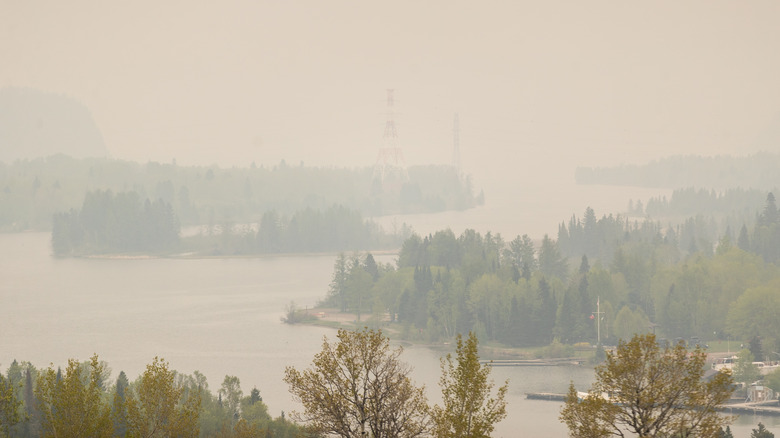Canadian Wildfires Have A Big Impact On The US. Here's How
Smoke from wildfires is not something to be taken lightly, as it impacts air quality for miles. The danger of it can be measured on the air quality index (AQI), a scale that goes from zero to over 300. Lower levels on the AQI scale mean wildfire smoke mostly impacts people who have existing conditions. As it goes higher, everyone is likely to be affected, even resulting in emergency-level conditions that are extremely dangerous to your health.
Data from Natural Resources Canada illustrates that the country has about 8,000 fires every year that burn over 2.1 million hectares. They can occur in most any part of the country, but they are less likely further north due to the cold. About half of all wildfires in Canada are caused by lightning strikes.
Technology to keep us safer in wildfire conditions has improved, including tools like the Google Maps feature to monitor fire movement. However, the smoke from these fires gets carried across the Canadian border and throughout the United States, impacting the health of everyone in its path. Only with both countries working together can the danger of wildfire smoke be mitigated.
How Canadian wildfires impact the US
Air pollution is extremely dangerous at any level, and wildfire smoke is no exception. In June 2025, wildfire smoke from Canada had an impact across the US. Iowa, Minnesota, and Wisconsin were under air quality alerts. A haze settled over the city of Cincinnati in Ohio. Smoke passed over the northeast, including Boston and New York City. Even the air quality in Florida was worsened.
Wildfire smoke travels from Canada across the United States carried along by the wind. Northern states are most vulnerable due to their closeness to Canada. But since Canada shares the entire US northern border, fires anywhere in the country can directly impact the health of US citizens, as seen from the June 2025 wildfires.
Wildfire smoke contains fine particulate matter (PM2.5), which is too small to be seen, so we are not aware that we are breathing it in. It is very dangerous, as it gets into the lungs and even into the bloodstream. It can cause sensitivity reactions like coughing and trouble breathing. Worse effects include a stroke, heart attack, reproductive issues, and neurological issues. For people who are often exposed to wildfire smoke, it can even cause long-term respiratory diseases.
What can be done about the Canadian wildfire impact?
Wildfires are most likely to occur when the weather is hot, dry, and windy. Monitoring weather conditions, especially when there is lightning, can quicken response times. Humans are also responsible for a good portion of wildfires from activities like dropping cigarettes on the ground, unsafe firework practices, and even arson. Despite public awareness campaigns, it can be difficult to convince people to be careful with any fire they handle when some simply do not care.
Cross-country cooperation is essential in mitigating fire danger. In May of 2025, the United States sent 150 firefighters and other personnel to help with the wildfires in Canada. In January of 2025, Canada sent firefighters and other staff to assist with the fires in southern California. When both countries help one another, both benefit with safer environments for all citizens.
Climate change has been worsening the conditions that cause wildfires. This results in them becoming more frequent, more dangerous, and harder to control. Unfortunately, the UN says we're failing miserably at controlling climate change. But as it is a global problem, if countries come together to try to stop its effects, we may be able to create safer air to breathe for everyone, no matter how close or far away they are from wildfires.


